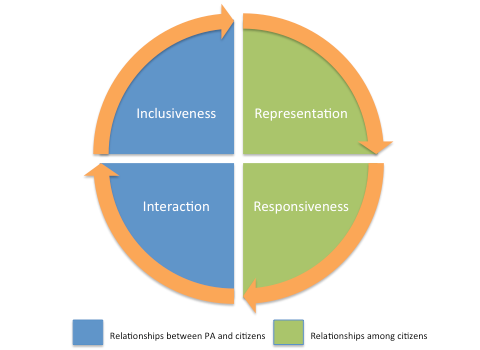by Mariafrancesca Sicilia and Ileana Steccolini (CIPFA faculty board member)
 This figures shows this double R and double I model of participatory budgeting.
This figures shows this double R and double I model of participatory budgeting.
Since its birth in Porto Alegre, participatory budgeting, ie the process through which citizens are actively involved in allocating a portion of budgetary resources, has attracted increased attention worldwide and been heralded as a possible answer to the current crisis of public finances, the shortfall in public administration legitimacy, and the loss of trust in representative democracies, or the need to foster local development and growth.
But under which conditions can participatory budgeting work? What do citizens want when participating in budgeting decisions?
According to a recent review of public budgeting, more needs to be known about participatory budgeting, and what citizens expects the process remains largely unexplored.
We recently explored how Italian citizens perceive participatory budgeting and the way in which it is implemented. We found four typologies of citizens being involved in participatory budgeting.
- First, the supporter in theory, but doubtful in practice, who think that participatory budgeting has a big potential for ensuring stronger involvement of citizens and collaboration among stakeholders, but points to the risks that the participatory process may become controlled by elites.
- Second, there are citizens who appear to be particularly worried about the trade-off between consensus and creativity, as they are see the risk of politicisation of participatory budgeting and that the need for consensus may even 'crowd-out' energies devoted to creating and designing projects.
- Third, there are the supporters of a community approach, which recognise importance to the balance between more targeted and collective needs in budgeting decisions, and pervasive information sharing and transparency.
- The fourth group of citizens are those aware of citizens’ importance, strongly focusing on the role of citizens as enablers and recipients of participatory budgeting and with a central role in differentiating resource allocation amongst different actors and types of projects.
All in all, it appears that the successful implementation of participatory budgeting depends on four central factors, ie responsiveness, representation, interaction and inclusiveness.
- Responsiveness concerns continuous attention to citizens’ needs and the capacity to use the participatory budgeting process to identify and respond not only to parochial needs but also to the collective needs. The development of a broader awareness and better understanding of the collective needs is not easy and requires time.
- Representation refers to the extent to which different interests, views and power positions have voice in the process and requires that decisions on how to spend public money are taken mainly through open debates, ensuring that voice and views are expressed, and reducing conflict, while selecting and compromising on possible solutions.
- Interaction refers to the establishment of a continuous two-way channel of communication between public administrators and citizens that is adjusted over time.
- Finally, inclusiveness is needed for achieving democracy and for guaranteeing a more equal allocation of resources.
The municipality is responsible for removing the barriers to citizens' participation by making the process more open, facilitating the collection of information from the various stakeholders (ie associations, specific interest groups, citizens), increasing the transparency of the process at each stage and ensuring broader access in terms, for example, of linguistic mediation and physical access.